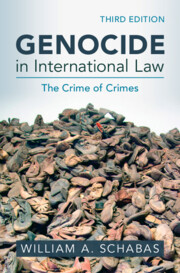Book contents
- Genocide in International Law
- Genocide in International Law
- Copyright page
- Dedication
- Contents
- Preface to the First Edition
- Acknowledgements
- Abbreviations
- Introduction
- 1 Origins of the Legal Prohibition of Genocide
- 2 Drafting of the Genocide Convention
- 3 Subsequent Normative Developments
- 4 Groups Protected by the Convention
- 5 The Specific Intent to Commit Genocide
- 6 Punishable Acts of Genocide
- 7 Cultural Genocide, Ethnic Cleansing and Other Acts Not Punishable under the Convention
- 8 ‘Other Acts’ of Genocide
- 9 Defences to Genocide
- 10 The Duty to Punish Genocide
- 11 Prosecution of Genocide by International Criminal Tribunals
- 12 State Responsibility and the Role of the International Court of Justice
- 13 Prevention of Genocide
- 14 Activity of International Organizations
- 15 Treaty Law Questions and the Convention
- Conclusions
- Bibliography
- Index
Conclusions
Published online by Cambridge University Press: 14 March 2025
- Genocide in International Law
- Genocide in International Law
- Copyright page
- Dedication
- Contents
- Preface to the First Edition
- Acknowledgements
- Abbreviations
- Introduction
- 1 Origins of the Legal Prohibition of Genocide
- 2 Drafting of the Genocide Convention
- 3 Subsequent Normative Developments
- 4 Groups Protected by the Convention
- 5 The Specific Intent to Commit Genocide
- 6 Punishable Acts of Genocide
- 7 Cultural Genocide, Ethnic Cleansing and Other Acts Not Punishable under the Convention
- 8 ‘Other Acts’ of Genocide
- 9 Defences to Genocide
- 10 The Duty to Punish Genocide
- 11 Prosecution of Genocide by International Criminal Tribunals
- 12 State Responsibility and the Role of the International Court of Justice
- 13 Prevention of Genocide
- 14 Activity of International Organizations
- 15 Treaty Law Questions and the Convention
- Conclusions
- Bibliography
- Index
Summary
Legal activity in the third quarter-century of the life of the Convention has greatly surpassed that of the first two quarter-centuries. This can be measured in terms of case law and scholarly writing. The interpretation of the Convention’s definition of genocide has remained quite narrow, and is essentially confined to physical genocide, destruction and extermination. There is potential for this to change in such a way as to extend the scope of the Convention to situations where groups are attacked with view to being driven from the territory where they have lived. This would require a degree of judicial activism. Care must be taken because of the danger of uncontrolled expansion of the definition. The phenomenon of politicized allegations of genocide is significant. Although there has been some resistance to the idea of a hierarchy of international crimes, genocide should remain ’the crime of crimes’.
- Type
- Chapter
- Information
- Genocide in International LawThe Crime of Crimes, pp. 787 - 802Publisher: Cambridge University PressPrint publication year: 2025

